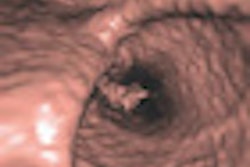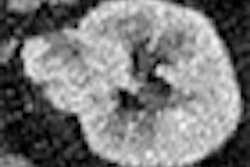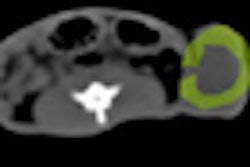The third major study of CT for acute appendicitis to appear in as many weeks has found that one institution's negative appendectomy rate dropped steadily over an 18-year period, in tandem with a rise in the use of CT to evaluate patients suspected of having appendicitis.
In the early 1990s, lead author Ali Raja, MD, and colleagues from Brigham and Women's Hospital in Boston were hoping that increased use of preoperative ultrasound might correlate with a decrease in the negative appendectomy rate (NAR). But the facility's results from 1990 to 1994 found no association between negative appendectomies and the use of ultrasound, and CT became the imaging modality of choice for patients with suspected acute appendicitis.
"Recent studies have reported mixed results with regard to the association between CT use and the NAR," they wrote. "Given these inconsistencies in the literature regarding the association between CT and the NAR as well as our access to data across an 18-year time span, we decided to evaluate this relationship at our institution" (Radiology online, June 7, 2010).
The present study used the hospital's medical records system to retrospectively compare patients suspected of having appendicitis who presented to the emergency department between 2003 and 2007 to those presenting between 1990 and 1994, "the period just before CT became commonly used at the authors' institution for the evaluation of appendicitis," Raja and colleagues wrote.
The authors reviewed surgery and pathology reports to establish the negative appendectomy rate, and they queried the radiology databases to determine which patients underwent preoperative imaging. They recorded the negative appendectomy rate as well as the proportion of patients who underwent preoperative imaging.
Various CT scanners were used over the 18-year study period, but all images were obtained at 120 kV. Axial section thickness was reduced from 10 mm to 5 mm over the study period, and oral contrast (barium sulfate, except for suspected perforation; in those cases, diatrizoate meglumine/diatrizoate sodium was substituted) was administered except for 1999 to 2000. The use of IV contrast began in 1996, and routine coronal reformations were added in 2006, the authors noted.
Between 1990 and 1994, appendectomies were performed on 971 patients presenting to the emergency department. The mean patient age was 33.7 years and 47% were male. There were pathologic findings consistent with appendicitis in 762 (78.5%) of the 971 patients.
Between 2003 and 2007, appendectomies were performed on 637 patients presenting to the ER. The mean patient age was 38.6 years and 46.9% were male. The researchers found pathologic findings consistent with appendicitis in 598 (93.9%) of the 637 patients.
Over the 18-year study period (1990 to 2007), the negative appendectomy rate decreased significantly, from 23.0% to 1.7% (p < 0.0001), while the number of appendectomies performed annually decreased significantly, from 217 to 119 (p = 0.0003), the group reported. Over the same period, the proportion of patients undergoing appendectomy who received preoperative CT increased significantly, from 1% to 97.5% (p < 0.0001), the authors wrote.
Although other imaging modalities such as ultrasound and MRI were occasionally used preoperatively, they wrote, their use was too infrequent and inconsistent to be included in the study.
"One explanation for the significant decreases in both the NAR and the number of appendectomies performed might be that the increased use of imaging has led to a decrease in the number of unnecessary appendectomies, which would support earlier results," Raja and colleagues wrote. "We also found that nearly all emergency department patients (97.5%) currently undergoing appendectomy at our hospital undergo preoperative CT."
The data also suggest that preoperative CT is associated with a decrease in the female-to-male negative appendectomy ratio, from 1.9:1 in 1990 to 0.9:1 in 2007, "implying that the use of CT may have been helpful in decreasing the number of negative appendectomies in women," they added.
The study showed a reduction in both negative appendectomies and the number of appendectomies in emergency department patients, which was associated with a significant increase in the rate of preoperative CT in patients undergoing appendectomy over the 18-year study period.
More studies will be needed to "assess the relative benefits of decreased NAR compared with the costs of CT and the risks of radiation exposure to help define the appropriate use of CT in the setting of suspected appendicitis," they concluded.
By Eric Barnes
AuntMinnie.com staff writer
June 22, 2010
Related Reading
Appendicitis: Positive CT outweighs lack of symptoms, May 27, 2010
Large study confirms CT's accuracy for acute appendicitis, May 20, 2010
Preoperative CT may reduce negative appendectomies in women, January 28, 2010
Noncontrast CT accurately diagnoses acute appendicitis in adults, January 25, 2010
Limit CT exams for appendicitis in kids, November 24, 2009
Copyright © 2010 AuntMinnie.com



















